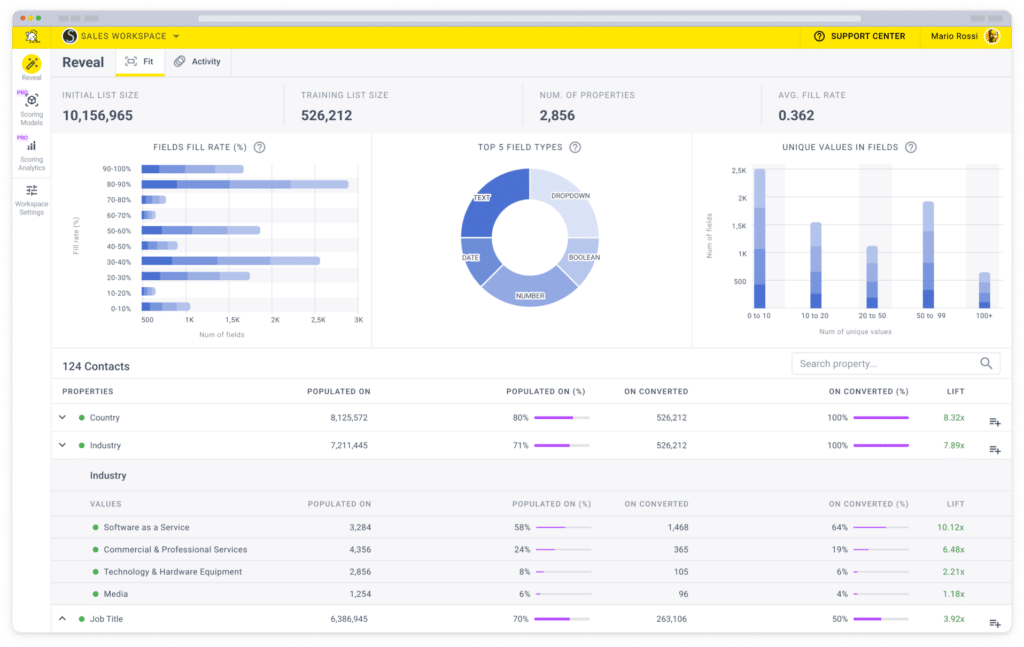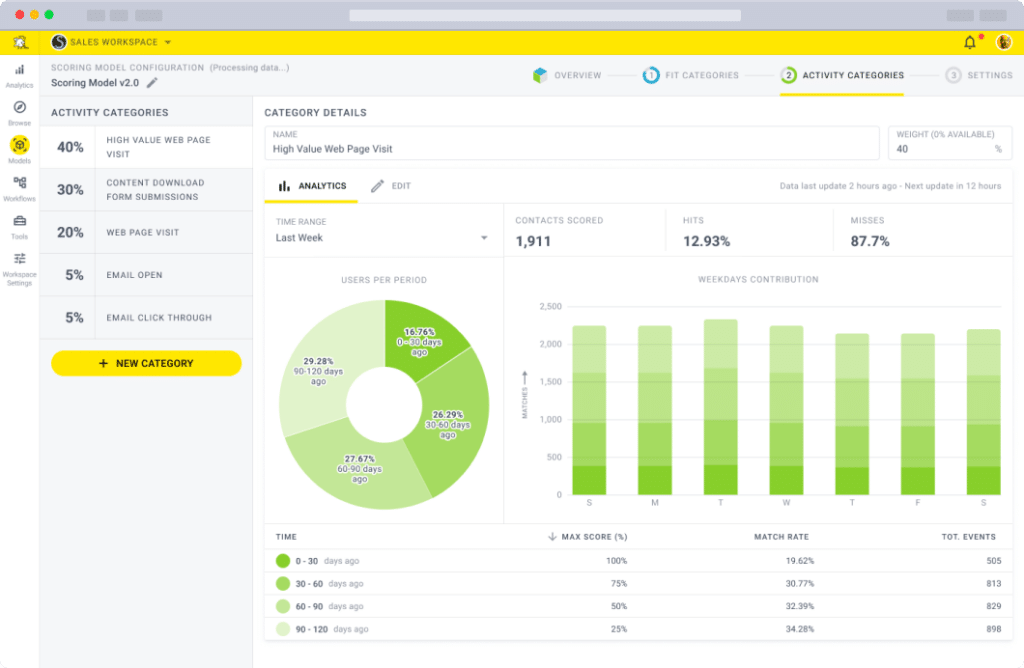Getting a potential customer into your sales funnel requires the right strategy.
But converting that prospect as soon as possible is another story entirely.
To shorten your sales cycle, you need to grab leads who are eager (or at least willing) to enter the buying process.
That’s why it’s pivotal to focus on nurturing qualified leads—and truly understanding your ideal customer profile.
Thankfully, with Breadcrumbs, you can do both.
Our lead scoring tool and ICP template can help you find and hone in on prospective customers who are more ready to buy. That means a shorter sales cycle and more aligned customers in your CRM.
Let’s take a closer look at how to accelerate revenue growth by shortening the sales cycle.
We’ll review some proven strategies and tools you can use to optimize and refine your sales process.
Ready to learn more?
Let’s get started.
Understanding the Sales Cycle
Your sales team likely has a sales process in place. But does it seamlessly align with your target customer and end goal?
If you’re seeing low conversion rates, the answer is no—and it’s time to make a change.
What is a Sales Cycle?
The sales cycle refers to the process of acquiring and converting leads into customers. It typically involves prospecting, qualifying, presenting, closing, and nurturing relationships with potential buyers.
The Importance of Shortening the Sales Cycle
Shortening the sales cycle is important because it reduces the time it takes for customers to move from initial contact to making a purchase. This boosts operational efficiency and accelerates revenue growth.
By understanding and optimizing the customer journey, you can better identify and remove any obstacles that may slow the sales process. This leads to a smoother and more satisfying customer experience.
But honestly? Everyone wins.
The sales rep, your customer, and your organization all benefit when you have an efficient sales process in place.
Using Breadcrumbs for Lead Scoring: A Key Strategy
Businesses lose billions every year by chasing the wrong ICP.
Let’s take a closer look at how lead scoring can help you focus on what matters—so you can shorten your sales process, prevent losses, and drive faster revenue growth.
The Role of Lead Scoring in Shortening the Sales Cycle
Lead scoring shortens the sales cycle by helping you prioritize and focus on the most qualified leads.
This accelerates the process from initial contact to conversion.
By assigning scores based on prospect activity and engagement, you can efficiently identify leads who are ready for further engagement, nurturing, and ultimately closing the deal.
An Introduction to Breadcrumbs: How Breadcrumbs Enhances Lead Scoring
At Breadcrumbs, we live and breathe sales.
That’s why all of our tools focus on helping B2B sales and marketing teams learn more about their target audiences.
For instance…
With our Reveal tool, you can uncover the secrets of your high-value contacts, including their firmographic data and online behavior. Named aptly, this tool “reveals” your Ideal Customer Profile (ICP) so you can capitalize on the most promising sales opportunities.
With your free Breadcrumbs Reveal account, you’ll instantly get a data-driven ICP and discover actions that predict a higher buying intent.
With our Copilot tool, you can create a lead scoring model using our AI-driven scoring software. Automatically build your models while keeping full authority over the scoring process.
With our Explore feature, you can better understand your top contacts—and what actions lead to conversions. You can also view, filter, sort, and segment prospects and customer data across your connected data sources. Analyze the latest trends and insights to better understand intent and create personalized experiences.
Book a demo to learn more about Breadcrumbs now.
Other Proven Strategies to Shorten the Sales Cycle
Now that you’re clear on some of the best lead scoring tools you can use, let’s quickly review some other ways sales leaders can create a shorter sales cycle:
Improving Sales Pipeline Management
To improve sales pipeline management, start by actively monitoring and tracking your leads throughout the entire customer journey.
Be sure to effectively segment your target market and leverage data analytics to gain insights into customer behavior. (More on this in a bit.)
You’ll also need to conduct regular pipeline reviews to identify potential bottlenecks.
Implementing other tools, such as CRM systems and automation software, can also help streamline and automate sales pipeline processes. With these tools, sales professionals can efficiently manage leads, follow up on opportunities, and nurture customer relationships in one place.
Enhancing Customer Engagement
To boost engagement, give your target audience consistent avenues to engage with your business.
For instance, you might have an AI-assisted chatbot on your website, host live Q&A calls on social media, and create an organic content marketing strategy.
If you run a SaaS business, the ladder is crucial to generating more website traffic and engagement.
With informative content, such as blog posts, white papers, and case studies, you can:
- Build domain authority to boost ranking potential
- Create a reputation grounded in expertise
- Encourage informed decision-making
- Solve customer problems
- Become a thought leader
- Attract ideal prospects
- Satisfy search intent
- Build trust
In fact, even one piece of content can help you reduce your sales cycle if you have the right SEO strategy, messaging, and value in place.
For instance, take Henry Meds, a telehealth company specializing in weight loss medication. Its article on semaglutide pills vs. injections explains which form gives better results to its potential customers:
Let’s review some ways this blog post helps shorten Henry Meds’ sales cycle.
Informed Decision-Making
Henry Med’s article helps customers discover the differences between Semaglutide pills and injections. This helps them choose the best option according to their unique preferences and lifestyle.
Trust in Transparency
At Henry Meds, transparency is a core value. The article is a transparent resource, showcasing the company’s expertise and commitment to providing accurate, reliable information to customers.
Addressing Customer Concerns
The article proactively addresses common concerns, allowing customers to overcome hesitation and move forward confidently in their decision-making process. It also reviews some product benefits to help potential customers feel more at ease. One such benefit is reliable customer support services, which are a must for customer satisfaction.
Searchable Information
Henry Meds optimized this article for search engines to give searchers the information they need. This also helps the brand aim for higher-ranking positions and gain a competitive edge.
Nurturing the Customer Journey
As part of its commitment to customer well-being, the article is a valuable resource throughout the decision-making journey, supporting customers at every step.
Empowering Sales Conversations
Henry Meds’ sales representatives are ready to discuss customers’ questions or concerns. Customers and reps can reference the article during conversations to facilitate more personalized discussions.
And that’s just from one piece of content.
Leveraging Data Analytics
Remaining data-informed and driven is pivotal to optimizing your sales cycle—consistently.
Monitor analytics daily and jot down key lessons.
Be sure to share these insights with your sales team so you can refine your approaches where necessary.
If possible, create a data analytics “task force,” so you always have a group of trusted sales reps with their fingers on the pulse. Or work with your sales leaders to establish a regular tracking and interpreting analytics protocol.
You also need a plan in place to help your team apply the lessons they’ve learned. Consider setting up a weekly meeting to decide which new strategies to test or implement.
Shorten Sales Cycle Strategies: A Step-by-Step Guide
When you’re ready to optimize your sales cycle, follow these steps:
Step 1: Set Up Your Tools
Solidify your buyer personas and lead scoring process with Reveal, Copilot, and Explore by Breadcrumbs.
Take advantage of other key software options, too, such as:
- A CRM to manage leads and customers (some will also allow sales calls and come with other communication features)
- A composable CDP to mine, clean, and store customer data from all of your data sources in one place
- Marketing automation software (think client portal, email marketing tools, and SMS marketing apps)
- Conversation Intelligence Tools (records, transcripts and analyzes the sales call and gives detailed insights about the deal
Step 2: Develop a Shortened Sales Cycle Strategy
Go into analysis mode and dig into all of the insights your tools have to help you shorten your sales cycle.
Apply these lessons to develop better sales strategies and marketing efforts.
For instance, you might learn that your ideal customers often download whitepapers before booking a demo. You might also learn that qualified leads often attend tech webinars before reaching out for more information.
In these scenarios, you can adjust your sales funnel to include more white paper and webinar opportunities across your marketing channels.
For instance, you might set up targeted ads focusing on grabbing prospects with lead magnets. In this case, you’d gate your webinar invitations and white papers (“your lead magnets”).
When an interested lead clicks on your ads, they’ll need to provide their contact information to access their free webinar ticket or white paper download. From here, you can nurture the prospect with tailored, segmented emails to encourage a meeting and (hopefully) a conversion.
Step 3: Measure Success and Adjust Your Approach
Continue tracking your sales and marketing outcomes and refining your sales approach.
You can also poll or survey your target audience for more insights.
Remember to make data analysis and application a pivotal step in your daily or weekly routine.
If possible, gather the sales leaders you trust most to pilot this process and keep you informed. Meet regularly for updates, and be sure to ask for indicators that prove their adjustments are leading to accelerated revenue growth.
Conclusion: The Power of a Shortened Sales Cycle
Your competitors move quickly—but you can move even faster with the right tools and strategies in place.
That’s why it’s vital to apply lessons and tech that can help you shorten your sales cycle as soon as possible.
With a passion for continuous improvement, you can always maintain a competitive edge.
If you’re ready to shorten the sales cycle and boost revenue growth, save this article and share it with your sales team. Then, work through the steps we’ve listed to optimize your sales approach.
And remember, to get a firm grip on your ICP, score leads, and understand buying intent, use Breadcrumbs—the only lead scoring software you’ll ever need.
Book your demo today, it’s free!





